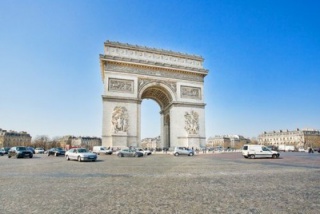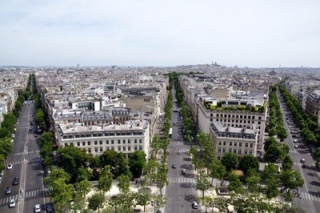Sotheby's International Realty
- 138 Avenue Victor Hugo
- 75116 PARIS, France
- +33 1 40 60 50 00
Sotheby's International Realty
- 50 rue d'Auteuil
- 75016 PARIS, France
- +33 1 56 26 56 55
Sotheby's International Realty
- 82 Avenue de Wagram
- 75017 PARIS, France
- +33 1 46 22 27 27
Sotheby's International Realty
- Place Sainte Foy - 2 Rue de Chézy
- 92200 NEUILLY, France
- +33 1 41 43 06 46
Sotheby's International Realty
- Place Sainte Foy - 2 rue de Chézy
- 92200 NEUILLY, France
- +33 1 41 25 00 00
Sotheby's International Realty
- 37-39 rue de Turenne
- 75003 PARIS, France
- +33 1 48 87 14 41

Paris 17th district - Etoile
Renowned for its proximity to the Arc de Triomphe, one of Paris' iconic landmarks, the prestigious neighborhood of Étoile captivates with its cosmopolitan atmosphere and harmonious blend of history and modernity.
The Avenue des Champs-Élysées, a majestic boulevard lined with luxury boutiques and renowned restaurants, serves as the backbone of this chic district. The Haussmannian buildings that flank it, often adorned with wrought-iron balconies and elegant architectural details, enhance its undeniable charm.
Étoile is also renowned for its upscale apartments and beautifully preserved private mansions. Residences in this neighborhood offer spacious and luminous interiors, sometimes featuring antique parquet floors, sophisticated moldings, and ornate fireplaces, showcasing exceptional craftsmanship and design.
In addition to its remarkable architectural heritage, the Étoile district is home to iconic landmarks such as the Arc de Triomphe, the pinnacle of the Champs-Élysées, offering spectacular panoramic views of Paris. Residents also benefit from proximity to the Palais des Congrès, a modern cultural and commercial center, as well as the Bois de Boulogne, a vast wooded park offering relaxation and recreational spaces.
Real estate prices in the Étoile neighborhood reflect its exclusivity and attractiveness, with apartments typically ranging between €11,000 and €15,000 per square meter.
It is an ideal residential choice for those seeking a prestigious address with easy access to city amenities and an elegant lifestyle in Paris.

Place Charles de Gaulle
Famed for its central location and monumental presence, Place Charles de Gaulle — formerly known as Place de l’Étoile — is one of Paris’ most iconic and sought-after addresses. Dominated by the Arc de Triomphe, this majestic roundabout serves as the convergence point of twelve grand avenues, including the legendary Champs-Élysées, offering breathtaking perspectives across the city.
The neighborhood surrounding the square exudes timeless elegance, with its impressive Haussmannian buildings and opulent private mansions. These residences often feature classic architectural elements such as intricate moldings, herringbone parquet floors, high ceilings, and expansive living spaces. Many enjoy unobstructed views of the Arc de Triomphe, adding to their rarity and prestige.
What makes the Place Charles de Gaulle district so distinctive is its perfect harmony between historical charm and modern sophistication. Luxury apartments here are meticulously maintained or beautifully renovated, seamlessly blending Parisian heritage with contemporary amenities.
The area also boasts a highly strategic location, offering immediate access to the Champs-Élysées, Avenue Foch, and Avenue Victor Hugo, as well as proximity to high-end boutiques, embassies, business centers, and green spaces like the Bois de Boulogne. The Palais des Congrès and several prestigious schools and institutions further enhance the district’s appeal for both families and international buyers.
Real estate values around Place Charles de Gaulle reflect its exclusivity, with prices for prime properties typically ranging from €12,000 to €16,000 per square meter. For those in search of a refined lifestyle, a prestigious address, and stunning views at the heart of Paris, Place Charles de Gaulle offers an unparalleled residential experience.

Avenue de Wagram
This iconic avenue, stretching majestically from the Arc de Triomphe to Boulevard Pereire, is renowned for its refined Haussmannian architecture and imposing private mansions.
Avenue Wagram borders one of Paris's most famous squares, the Arc de Triomphe, offering a spectacular setting with its grand converging avenues and panoramic views of the city. This prestigious neighborhood attracts an international clientele seeking a residential address of high standing, combining the classic charm of Paris with modern comfort.
Properties along Avenue Wagram consist of luxurious residences, ranging from spacious apartments to opulent private mansions. These properties are distinguished by their elegant interiors, often adorned with antique parquet floors, delicate moldings, and period fireplaces, while offering modern amenities and high-end finishes.
The architecture along Avenue Wagram bears witness to Paris's history and prestige, with its elegant facades and exquisite architectural details. Each building tells a unique story of Parisian elegance, captivating buyers in search of cultural heritage and sophisticated lifestyle.
Residents of Avenue Wagram not only enjoy prestigious residential surroundings but also privileged access to some of Paris's finest restaurants, luxury boutiques, and green spaces. The Étoile district is renowned for its dynamic cultural life and cosmopolitan atmosphere, offering an incomparable quality of life in the heart of the capital.
Real Estate Prices:
In terms of real estate prices, Avenue Wagram in Étoile, 17th arrondissement of Paris, ranks among the highest in the French capital. Luxury properties along this prestigious avenue typically range between €10,000 and €12,000 per square meter, and even higher for the most exceptional properties offering panoramic views of the Arc de Triomphe and its surroundings.




